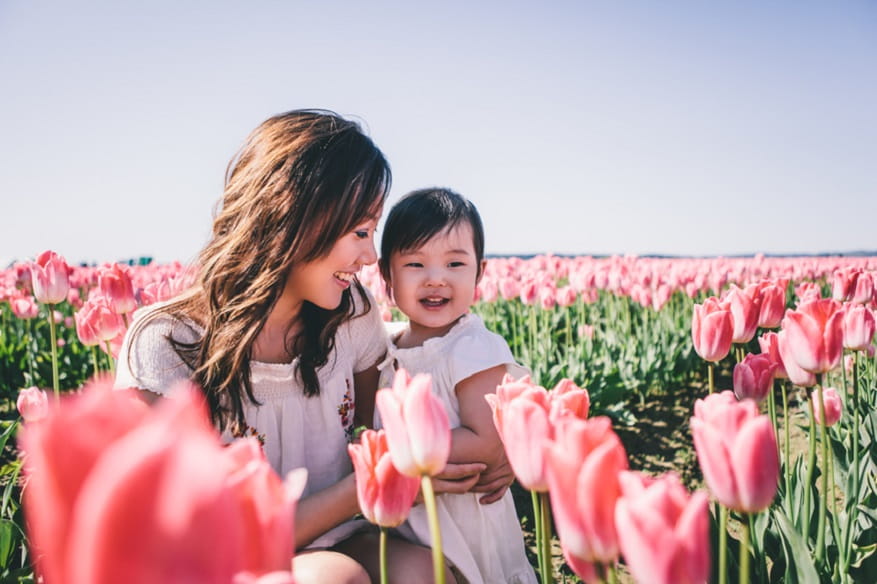Petal Power: 5 Ways to Teach with Tulips

Your child is growing, and during spring, so is the world around her—making the season a perfect time to teach children about colors, plants, and the importance of caring for the natural world.
Nurturing your children’s curiosity about how things grow is as easy as taking a walk around your neighborhood to look for emerging shoots, flowers, and bright green leaves unfurling from the trees. But you can also take that curiosity to a whole other level with the help of that quintessential spring flower, the tulip. Available in bunches at this time of year, the tulip is the perfect flower to encourage own budding scientist to look, think, and learn even more about the natural world.
1. Tulips can teach…the parts of a flower.
Because their individual parts are easy for small hands to grab, tulips are great for dissecting. Find a few big tulips at a flower shop or in your garden and help your little scientist separate all the different parts of the tulip, explaining what each part does to help the flower stay alive and grow. After all, every part of a flower has a job to do!
Tip: A magnifying glass is a great tool for helping children look closely at all the parts of a flower.
- Leaves: Leaves help a flower use sunlight to turn nutrients from the soil into food.
- Stamen: The “male” part of the flower that makes pollen.
- Pistil: The “female” part of the flower that has eggs that need pollen to turn into new flowers.
- Pollen: The powder that is made in parts of the flower that sticks to your fingers and turns them yellow.
- Petals: Colorful and fragrant petals help attract bugs and birds that help move the pollen from flower to flower, which helps the flower make new seeds.
- Stem: The stem supports the flower and moves water and nutrients up to the rest of the flower like a straw.
2. Tulips can teach…patience.
Planting tulips teaches patience, because they are often planted in fall—many months before they’ll flower in the spring. Although tulips can be grown from seeds, most gardeners use bulbs. With a shape similar to a small onion, each tulip bulb actually has a complete baby plant tucked away inside! These hearty little things don’t need much more than water, as the bulb also has food inside to help the plant grow into a flower year after year.
3. Tulips can teach…colors.
Tulips can be found in almost every color of the rainbow, which make them a great teaching tool for learning color vocabulary. Go on a walk around the neighborhood, a flower shop, or a nursery, and have your child find tulips or other flowers in every color. How many colors can you point out?
4. Tulips can teach…respect for living things.
When children can identify the parts of a flower that help it grow, they will begin to understand that plants and flowers are living things. Many children love picking flowers and leaves, so it’s important to instill a sense of respect for plants (especially when they’re growing in other people's’ gardens!) A good rule of thumb is to have children ask permission before they pick a flower. If a flower is in a public park or neighbor’s yard, you can show your child how to smell, look at, and admire a flower without picking it. Respect for plants and nature helps children develop compassion, respect for belongings and the environment, and positive feelings about themselves as caring people.
5. Tulips (and all flowers) can inspire…joy.
Take your tulip and flower-learning to the next level by traveling to one of these great events.
- Skagit Valley Tulip Festival, WA (April): This driving-tour festival, situated between Seattle and Vancouver, B.C., showcases miles and miles of tulip farms. Highlights include Tulip Town, with colorful fields full of 80 kinds of tulips and kid-friendly activities like trolley rides, kite flying, and art stations.
- Dallas Blooms, TX (Through April 9, 2017): Imagine a colorful wonderland with over 500,000 blooms, including tulips, daffodils, Dutch Iris and hyacinths, pansies, violas, poppies and thousands of other spring-blooming flowers. Kids’ activities happen every Monday and Tuesday, including guided walks, face painting, a petting zoo, and story time.
- Tulip Time in Holland, Michigan (May 6-14, 2017): Love tulips? How about 4.5 million tulips? Then this is the flower festival for you. Explore the town’s beautiful blooms and join in the celebration of Dutch heritage with dancing, a traditional marketplace, parades, and delicious food.
- The Epcot International Flower & Garden Festival, FL (March 1-May 29, 2017): Leave it to Walt Disney World to take flower festivals to the next level! All spring long, dozens of different gardens showcase flowers from around the world, as well Disney-themed flower and plant sculptures showcasing everyone's favorite characters, from Beauty and the Beast to Peter Pan.
- National Cherry Blossom Festival, Washington D.C. (March 15-April 16): In 1912, the mayor of Tokyo gave Washington, D.C. the gift of 3,000 cherry trees, and the National Cherry Blossom Festival was born. Tourists from all over the world come to Washington’s Tidal Basin to see the beautiful blooms between late March to early April, as well as to take part in parades, kite festivals, fireworks, and other events celebrating Japanese culture.





